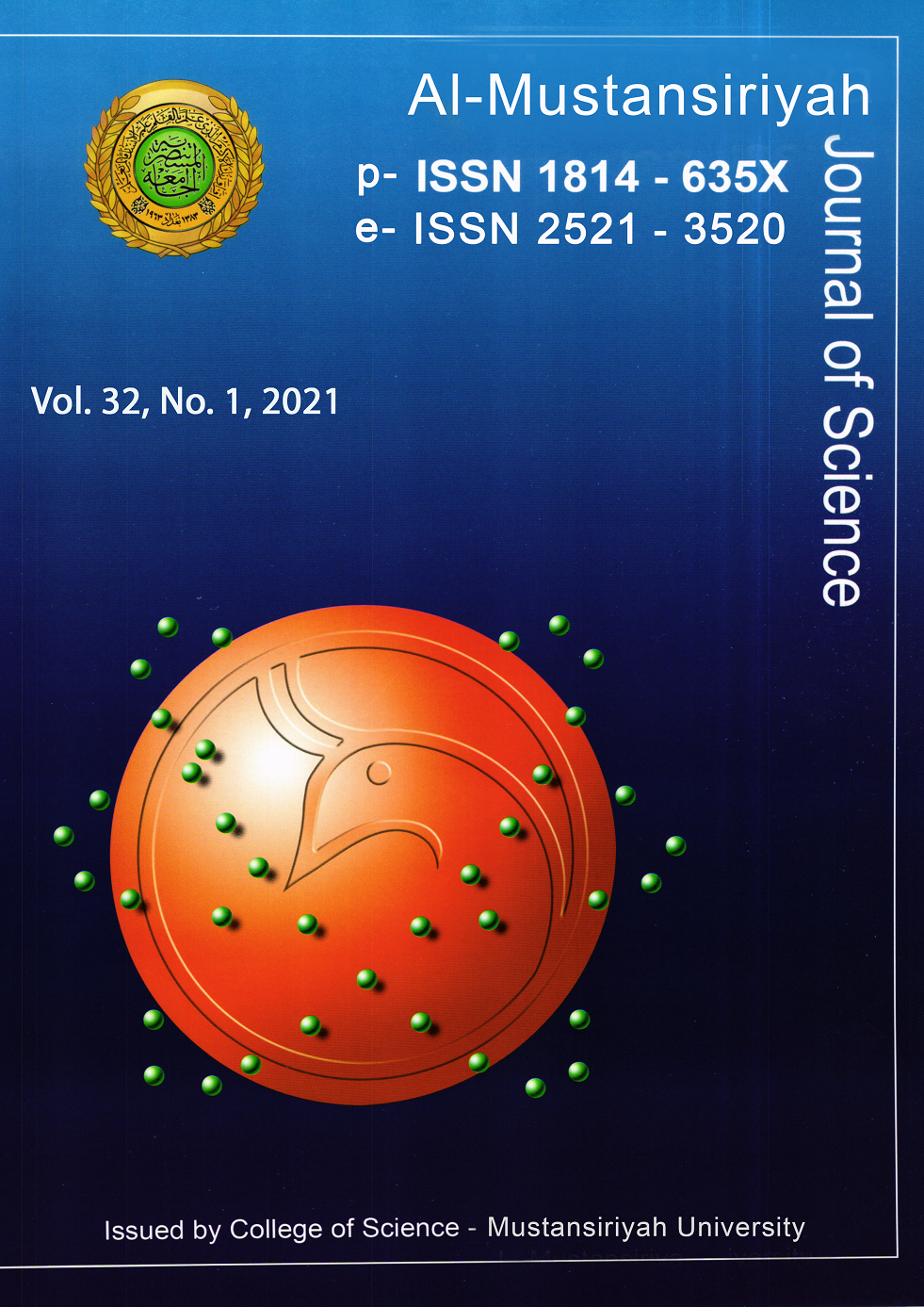Causative Microorganisms and Antibiotics Susceptibilities in Children with Urinary Tract Infection
DOI:
https://doi.org/10.23851/mjs.v32i1.948Abstract
Generally, treatment of urinary tract infection (UTI) in children is a difficult task, due to development of high resistance against antibiotics. The object of this study is to investigate the greatest causative microorganisms, their susceptibility and resistance to antibiotics in children suffering from UTI in Baghdad. A total of 810 urine samples were collected from suspected cases of UTI in children patients of ages (1 day to 12 years) of both sexes. Urine specimens were examined by urinalysis and cultured for isolation of microbial agents. In this study, Bacterial growth was obtained in 202 samples (24.39%) out of 810 urine samples. Various pathogenic organisms were isolated, which represented by A) Gram-Negative bacilli include Escherichia coli (41.58%), Enterobacter spp. (13.68%), Proteus Mirabilis (12.78%), Acinetobacter spp. (4.45%), Providencia spp. (4.45%), Pseudomonas aeruginosa (3.46), Klebsiella pneumoniae (2.47%), Citrobacter spp.(0.49%), Salmonella Spp.(0.49%), B) Gram- Positive cocci: Staphylococcus aureus (11.38%), Enterococcus faecalis (1.98%) and Streptococcus agalactiae (1.48%) C) Candida albicans (0.9%).). According to antibiotic susceptibility test, mostly the isolates were resistant to Nalidixic acid (67.05%), cefotaxime (59.40%) and cefepime (50.49%). Mostly Gram-Negative bacilli were responsible for UTI, and maximum recurrent isolated bacteria were Escherichia coli. The isolated bacteria were found to be sensitive to Imipenem, Amikacin, and ciprofloxacin. Therefore, the selection of antibiotic therapy in UTI should depend on the native sensitivity form of the infecting organism.Downloads
References
E. D. Balighian and M.G. Burke. Urinary tract infections in children. Pediatrics in Review, Vol .39, No 1, P. 3-12, 2018.
S. L. Chang and L. D. Shortiffe. Pediatric urinary tract infections. Pediatr Clin N Am. Vol 53, No3, P 379-400, 2006.
E. J. S. Nelson. Textbook of pediatrics. In: Behrman RE, Kleigman RM., Jenson HB, editors. Urinary tract infection and vesicoureteral reflux 19th ed. Philadelphia: Saunders. Elsevier. PP.1829-1830, 2011
K. Tullus and N. Shaikh. Urinary tract infections in children. Lancet.,Vol 395, No10237, P.1659-1668, 2020.
N. Shaikh and A. Hoberman. Urinary tract infections in children: Epidermiology and risk factors. In: Post T.W, editor. Up-to-date. Waltham.AM. 2010
K. B. Roberts. Revised AAP Guide line on Urinary Tract Infections in Febrile infants and young children. Am Fam Physician. Vol 86, No10, P. 940-946, 2012.
World Health Organization. Urinary tract infections in infants and children in developing countries in the context of IMCI. WHO-FCH-CAH-05.11.pdf.
K.B. Roberts. Urinary tract infection: clinical practice guideline for the diagnosis and management of the initial UTI in febrile infants and children 2 to 24 months. Pediatrics. Vol 128, No3, P.595-610, 2011.
B.R. Raghubanshi, D. Shrestha, M. Chaudhary, B.M.S.Karki and A.K. Dhakal .Bacteriology of urinary tract infection in pediatric patients at KIST medical college teaching hospital. J. Kathmandu Med. Coll., vol. 3, no. 1, P. 21-25, 2014.
L. B. Shrestha, R. Baral and B. Khanal. Clinical, etiological and antimicrobial susceptibility Profile of Pediatric urinary tract infections in a tertiary care hospital of Nepal. BMC Pediatrics, Vol 19, No 1, P. 36, 2019.
M. Abuhandan, B. Guzel and H. Ciftci. Antibiotic sensitivity and resistance in children with urinary tract infection in Sanliurfa. Turkish Journal of Urology. Vol 39, No. 2, P.106-110, 2013.
J. E. Yoon, W. K. Kim, J. S. Lee, K. Shin and T. HaAntibiotic susceptibility and imaging findings of the causative microorganisms responsible for acute urinary tract infection: a five -year center study. Pediatr. Vol. 54, No. 2, P. 79-85, 2013.
A.A. Paschke, T. Zaoutis, P.H. Conway, D. Xie and R. Keren. Previous antimicro-ial exposure is associated with drug-resistant urinary tract infections in children. Pediatrics. Vol. 125, No. 4, P.664-672,2010.
S. Farshad, R, Ranjbar and M. Anvarinejad. Emergence of multidrug resistant strains of Esherichia coli isolated from urinary tract infections. The open conference Proceedings: Journal 1 (1) P.192-196, 2010.
J. L. Robinson, J. C. Finlay, M. E. Lang, R. Bortolussi. Urinary tract infections in infants and children: Diagnosis and management. Paediatr. Child Health. Vol 19, No 6, P.315-325, 2014.
J.J Zorc, D.A. Kiddoo, K. N. Shaw. Diagnosis and management of Pediatric Urinary Tract Infections. Clin. Microbiol. Rev. Vol 18, No 2 P. 417-422, 2005.
J. Vandepitte, J. Verhaegem, K. Engbaek, P. Rohner, P. Piot, C. C Heuck. World Health Organization Geneva. Basic Laboratory Procedures in clinical Bacteriology 2nd edition P 103-120.2003.
National Committee for Clinical Laboratory Standards. Performance Standards for Antimicrobial susceptibility testing; Twelfth Informational Supplement. Approved Standared M100-S12.Wayne PA: NCCLS; 2002.
V. Bhat and H. Vira. (2018). Quality Control Issues in Antibiotic Susceptibility Testing by Disc Diffusion Technique. Clin Infect Dis 2: 104.2018.
G.M Stephens, S. Akers, H. Nguyenand H. Woxland. Evaluation and management of urinary tract infections in the school-aged child. Prim Care, Vol. 42, No.1, P.33-41, 2015.
H.D. Marston, D.M. Dixon, J.M. Knisely, T.N. Palmore and A.S.Fauci. Antimicrobial Resistance. Jama, Vol 316, P. 1193-1204, 2016.
A. Leung, A. Wong, A. Leung and K.L. Hon. Urinary Tract Infection in Children. Recent Pat Inflamm Allergy Drug Discov. Vol 13, No 1, P.2-18, 2019.
Downloads
Key Dates
Published
Issue
Section
License
(Starting May 5, 2024) Authors retain copyright and grant the journal right of first publication with the work simultaneously licensed under a Creative Commons Attribution (CC-BY) 4.0 License that allows others to share the work with an acknowledgement of the work’s authorship and initial publication in this journal.






















